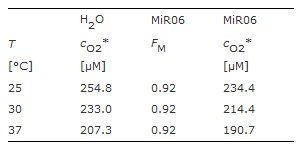MiPNet06.03 POS-calibration-SOP
Template:OROBOROS navigation line page name
| Polarographic oxygen sensors: calibration, accuracy and quality control SOP. »Bioblast pdf« |
» Versions
OROBOROS (2015-05-10) Mitochondr Physiol Network
Abstract: Gnaiger E (2015) Polarographic oxygen sensors: calibration, accuracy and quality control SOP. Mitochondr Physiol Network 06.03(13):1-8.
High-resolution respirometry critically depends on accurate calibration of the polarographic oxygen sensors which respond to partial oxygen pressure. Expressing the oxygen signal in terms of partial pressure has several advantages, but respiration is expressed in molar units related to biochemical stoichiometries. Conversion of oxygen partial pressure to oxygen concentration requires accurate information on oxygen solubilities in experimental incubation media. Absolute errors up to 10% are commonly found in the established literature. The oxygen solubility of mitochondrial respiration medium MiR06 relative to pure water (oxygen solubility factor, FM) is 0.92, accurately determined (for MiR05, i.e. MiR06 without catalase; MiPNet14.13) at 37 °C and 30 °C. At air saturation at standard barometric pressure (100 kPa) and 37 °C, the partial oxygen pressure is 19.63 kPa, and the oxygen concentration is 190.7 µM in MiR06. A clean and ready-to-use O2k-Chamber is a requirement for saving time and quickly calibrating the polarographic oxygen sensors.
- » Product: OroboPOS, Oxygraph-2k, O2k-Catalogue
• O2k-Network Lab: AT_Innsbruck_OROBOROS
Labels: MiParea: Instruments;methods
HRR: Oxygraph-2k, Protocol"Protocol" is not in the list (Oxygraph-2k, TIP2k, O2k-Fluorometer, pH, NO, TPP, Ca, O2k-Spectrophotometer, O2k-Manual, O2k-Protocol, ...) of allowed values for the "Instrument and method" property.
O2k-SOP
Further details
- O2k-Manual: »MiPNet19.18D_O2k-Calibration«
- Next step of instrumental quality control: »MiPNet14.06 InstrumentalBackground«
- Forstner H, Gnaiger E (1983) Calculation of equilibrium oxygen concentration. In: Polarographic Oxygen Sensors. Aquatic and Physiological Applications. Gnaiger E, Forstner H (eds), Springer, Berlin, Heidelberg, New York:321-33. »Bioblast Access«
Response time of the POS
MitoPedia O2k and high-resolution respirometry:
O2k-Open Support
The response time of the Polarographic oxygen sensor is assessed in the Stirrer test that is part of a full Sensor test. A quantitative interpretation of the stirrer test will yield the time constant of the sensor. Such a quantitative calculation is indeed necessary for kinetic work. However, to access the suitability of a sensor for standard steady state work each user will soon gain the necessary experience to judge the outcome of a stirrer test.
- >> Example: Download here.
For how to improve the response time of a POS, see Slow responding sensor.
The response time of the sensor is just one of several factors determining the time resolution.
Stirrer test
MitoPedia O2k and high-resolution respirometry:
O2k-Open Support
The response time of the POS can be most conveniently checked by a stirrer test, see MiPNet06.03_POS-Calibration-SOP, section 3. The stirrer test is part of the Sensor test and of our proposed quality checks before every experiment described in the link above. see If the results of a stirrer test are not satisfactory the procedures suggested for a Slow responding sensor should be followed. DatLab supports an automatically controlled stirrer test [F9].
Background information
After switching off the stirrer the electrolyte reservoir will quickly be depleted of oxygen by the oxygen consumption of the sensor. Oxygen can only reach the sensor now in a unstirred diffusion process, therefore a new and lower equilibrium O2 concentration is established in the vicinity of the sensor. After switching the stirrer on again the O2 concentration near the sensor is quickly brought back to the same level as elsewhere in the chamber, however the sensor takes some time to respond to this change. Thus the response time of the sensor can be determined. A stirrer tests does not influence the O2 concentration in the entire chamber. A stirrer test can not be at a chamber oxygen concentration of zero (or near zero) because no change in the O2 signal will result.
This article is cited in
- Rodriguez JV, Pizarro MD, Scandizzi AL, Guibert EE, Almada LL, Mamprin ME (2008) Construction and performance of a minibioreactor suitable as experimental bioartificial liver. Artif Organs 32:323-8. »PubMed 18370948«



